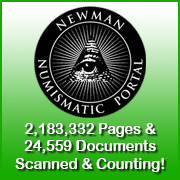
About UsThe Numismatic Bibliomania Society is a non-profit association devoted to the study and enjoyment of numismatic literature. For more information please see our web site at coinbooks.org SubscriptionsThose wishing to become new E-Sylum subscribers (or wishing to Unsubscribe) can go to the following web page link MembershipThere is a membership application available on the web site Membership Application To join, print the application and return it with your check to the address printed on the application. Print/Digital membership is $40 to addresses in the U.S., and $60 elsewhere. A digital-only membership is available for $25. For those without web access, write to: Terry White, Treasurer AsylumFor Asylum mailing address changes and other membership questions, contact Terry at this email address: terrywhite5475@yahoo.com SubmissionsTo submit items for publication in The E-Sylum, write to the Editor at this address: whomren@gmail.com BUY THE BOOK BEFORE THE COINSale Calendar |
- WAYNE'S WORDS: THE E-SYLUM SEPTEMBER 26, 2018
- NEW BOOK: GOLD COINS OF NEW ORLEANS MINT 3RD ED.
- NEW BOOK: FLYNN'S SEATED LIBERTY DOLLARS, 2ND ED.
- NEW BOOK: 2019 NORTH AMERICAN COINS & PRICES
- NEW BOOK: CHARGE COIN REFERENCE GUIDE
- NEW BOOKS: AMERICAN JOURNAL OF NUMISMATICS 29 & 30
- NEW BOOKS: MINT TREASURER BENJAMIN RUSH
- INDE ET LIB FIXED PRICE LISTS ON NEWMAN PORTAL
- USING NATIONAL BANK CHARTER INFORMATION
- MONEY TALKS: HISTORY OF THE ANS
- CONTEMPORARY COUNTERFEIT U.S. COINS SOUGHT
- NOTES FROM E-SYLUM READERS: SEPTEMBER 23, 2018
- ICELANDIC TOKEN PHOTOS ONLINE
- VOCABULARY TERMS: REISSUE, REPLICA, RESTRIKE, REVISION
- HENRY PHILLIPS, JR. (1838-1895)
- COLLECTORS UNIVERSE TERMINATES DAVID HALL
- MINT NEWS BLOG INTERVIEWS DAVID FANNING
- ARCHIVES FALL 2018 AUCTION #5
- SELECTIONS FROM FRANK ROBINSON AUCTION 106
- NUMISMATIC NUGGETS: SEPTEMBER 23, 2018
- WAYNE'S NUMISMATIC DIARY: SEPTEMBER 23, 2018
- COINS DISCOVERED FOLLOWING TYPHOON MANGKHUT
- ROYAL MINT BOOSTS COLLECTIBLE COIN PRODUCTION
- EXHIBIT: MEDALLIC IMAGES OF WAR
- CARSON CITY COIN PRESS STRIKES NEWSPAPER MEDAL
- ROYAL CANADIAN MINT'S 3D SUPERMAN
- THE 3D-PRINTED HARRIET TUBMAN $20 STAMP
- NEW EUROPEAN €200 AND €100 BANKNOTES
- NEW YORK STORE ACCEPTS MEXICAN CASH
- LOOSE CHANGE: SEPTEMBER 23, 2018
- THE CASE OF THE MURDEROUS NUMISMATIST
- FEATURED WEB SITE: SILVER ART COLLECTORS
Click here to access the complete archive
To comment or submit articles, reply to whomren@gmail.com
Content presented in The E-Sylum is not necessarily researched or independently fact-checked, and views expressed do not necessarily represent those of the Numismatic Bibliomania Society.
WAYNE'S WORDS: THE E-SYLUM SEPTEMBER 26, 2018
 This week we open with EIGHT new books worth
checking out, updates and reviews regarding the Newman Numismatic Portal, and a talk on the history of the American Numismatic Society.
This week we open with EIGHT new books worth
checking out, updates and reviews regarding the Newman Numismatic Portal, and a talk on the history of the American Numismatic Society.
Other topics this week include contemporary counterfeit U.S. coins, tokens from Iceland, replicas and restrikes, Henry Phillips, Jr., Benjamin Rush, Frank Katen, coin and paper money auctions, the PAN Show, the Harriet Tubman stamp, and hyperinflation money.
To learn more about New Orleans Mint gold, Seated Liberty dollars, charge coins, woodworking coins, the Knossos Labyrinth bronze, the earliest dated U.S. communion token, Medallic Images of War, the Crime-Solving Counterstamp, and the Case of the Murderous Numismatist, read on. Have a great week, everyone!
Wayne Homren
Editor, The E-Sylum
NEW BOOK: GOLD COINS OF NEW ORLEANS MINT 3RD ED.
Author Doug Winter has published a new edition of his book on New Orleans Mint gold. Here's some information from his web site. -Editor
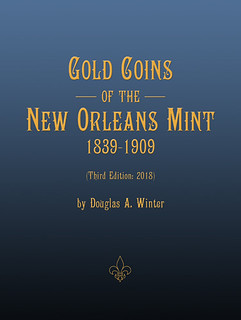 The brand new Third Edition of Doug's reference book, Gold Coins of the New Orleans Mint:
1839-1909, is now available for purchase.
The brand new Third Edition of Doug's reference book, Gold Coins of the New Orleans Mint:
1839-1909, is now available for purchase.
This hardcover, 384 page, full-color book is printed here in the United States. For now, there are 100 copies in our office in Portland, OR. We are in the process of numbering and signing them, and preparing them for shipping to their new home in your reference library.
The first 50 copies we had printed for the ANA were snapped up quickly, and the rave reviews have started to come in. This is truly a "coffee table" book, the size of a large auction catalogue, with the most current information on New Orleans gold available, including rarity, population, and detailed die variety descriptions with color photos.
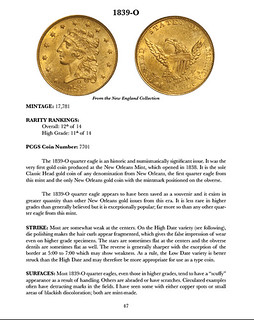
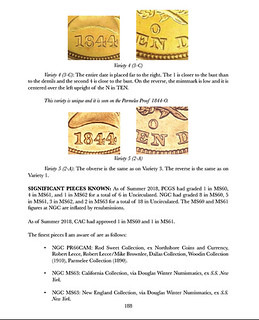
The book lists for $69.95, "signed, numbered and shipped." Doug had some at the recent Philadelphia ANA show, including some special versions made just for the show. -Editor
I wanted to have something special at the 2018 Philadelphia ANA show and I had a crazy last minute idea: for the presentation I was giving the US Gold Coin Collectors Club, why not produce a limited edition of special hardcover copies of my brand-spanking-new, soon-to-be-released, third-edition reference titled Gold Coins of the New Orleans Mint, 1838-1909?
In case you’ve missed yet another facet of the current Technology Revolution, book printing has changed dramatically in the past few years and you can now print small runs of super high-quality books (soft and hardcover!) via online American printers. This meant that I could quickly and efficiently print a special run of 50 copies for the 2018 ANA.
I shipped the books from my office in Portland Oregon to the convention center with just one unforeseen bump: the ever-helpful union workers charged me $450 to load, move and unload four boxes.
I saved 20 copies for the above-referenced presentation, offered 15 for sale, kept copy #1 and #2 for myself and Jenna, and shipped 13 from my office after the show to my best clients as a “thank you.” I’d like to think that the very limited 2018 ANA print run of this important book will be recognize, some day, as a numismatic literature rarity.
If you didn’t have a chance to buy a copy from me, here are a few images of what you missed. Note the special presentation label with each copy being signed and numbered especially for this show.
That’s the bad news. The good news is that I will be offering hardcover and softcover copies of this book within the next month or two. So if you missed the 2018 ANA edition, you can still have a copy of this important new book.
Ordering information will be on my website (raregoldcoins.com) soon.
For more information, or to order, see:
Your Wait is Over (https://raregoldcoins.com/new-book/)
DWN Press Creates A Numismatic Book Rarity
(https://raregoldcoins.com/blog/2018/8/30/dwn-press-creates-a-numismatic-book-rarity)
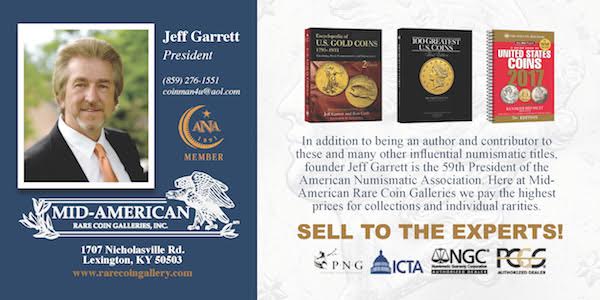
NEW BOOK: FLYNN'S SEATED LIBERTY DOLLARS, 2ND ED.
Kevin Flynn provided this information on the new edition of his book on Seated Liberty Dollars. Thanks! -Editor
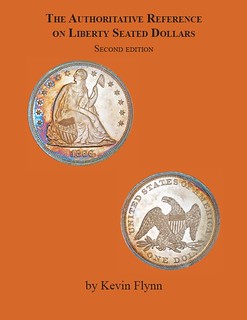 Authoritative Reference on Liberty Seated Dollars, Second Edition by Kevin Flynn, 8-1/2 * 11,
272 pages, softcover only. Published by Brooklyn Gallery Coin & Stamps.
Authoritative Reference on Liberty Seated Dollars, Second Edition by Kevin Flynn, 8-1/2 * 11,
272 pages, softcover only. Published by Brooklyn Gallery Coin & Stamps.
In 2014, I wrote the first edition on the Liberty Seated Dollars, which sold out quickly on the limited printing. Since then I researched and wrote books on the Liberty Seated Half Dimes, Twenty cent pieces, and Quarters. In researching these other series I uncovered new archive records that helped provide a better understanding of the history of the series, which is included in the Liberty Seated Dollar second edition.
My primary focus now is research and a book on all restrikes of all series. The research on the Liberty Seated Dollar series was completed and added to the second edition. For the Liberty Seated series this includes the 1851, 1852, 1853, and 1854 dollar proof restrikes, 1863 and 1864 In God We Trust patterns, 1865 IGWT patterns, and 1866 No IGWT patterns. One of the primary objectives was to determine approximately when these coins were struck and sold. Many of these restrikes used the same reverses and used for the proof coins of the same series. Using the diagnostics of the proof coins and comparing to those on the restrikes provided an accurate estimate on when they were struck. The auction records from 1850 through 1900 were studied, which helped understand when these restrikes were offered by sale and if a pattern could be seen on who was distributing them. These auction records are presented in the appropriate sections for each of the restrikes.
This book still includes all of the doubled dies, misplaced, dates, repunched dates, and repunched mint marks as seen in the first book.
Brooklyn Gallery will be publishing and distributing the second edition. You can contact them at Brooklyn Gallery Coins & Stamps, 8725 4th Ave, Brooklyn NY11209, by email at info@brooklyngallery.com, or phone at 718-745-5701. Retail is $69.95 plus shipping. Brooklyn is offering a special on this book until November 1st, 2018 of 20% off or $55.95 plus shipping. Please speak to Joe at Brooklyn if any questions.
NEW BOOK: 2019 NORTH AMERICAN COINS & PRICES
Krause Publications emailed this book announcement earlier this week about the new edition of their North American Coins & Prices book. -Editor
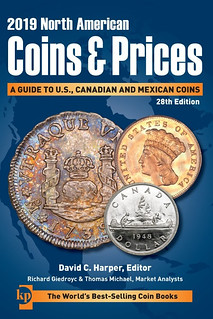 With tens of
thousands of individual coin listings, more than 6,500 coin images and updated coin values for the United States, Canada and Mexico, 2019 North American Coins & Prices, 28th
Edition, is the ultimate single-source reference for coin coverage of North America.
With tens of
thousands of individual coin listings, more than 6,500 coin images and updated coin values for the United States, Canada and Mexico, 2019 North American Coins & Prices, 28th
Edition, is the ultimate single-source reference for coin coverage of North America.
Organized by country, government, denomination and date of issue, this expanding reference remains a clear, detailed and easy-to-use resource for a vast array of highly collected coins. The U.S. section offers listings for early Colonial coins and tokens of the 17th and 18th centuries through Federal issues from 1791 to date.
Mexico listings begin in 1701 and flow chronologically through many government changes, while Canada’s listings begin with its earliest unified coinage in 1858 and continue through their many 21st century commemorative issues.
Inside, you’ll find:
- Descriptions and photos for coin issues of the United States, Canada and Mexico
- Pricing in the most frequently encountered and significant grades of preservation
- Historical market performance graphs for U.S. coins of note
- A Grading Guide to U.S. and World Coins
For nearly three decades, North American Coins & Prices has provided unique, complete and authoritative information. Experience for yourself why this exceptional reference is the best guide of its kind on the market.
For more information, or to order, see:
2019 North American Coins & Prices, 28th Edition
(https://www.shopnumismaster.com/2019-north-american-coins-prices-r7877)
About the Author
David C. Harper is editor of Numismatic News, executive editor of World Coin News and editor of U.S. Coin Digest. He has more than 40 years of numismatic
experience and has received numerous awards from the Numismatic Literary Guild.
Author: David C. Harper, Editor; Richard Giedroyc & Thomas Michael, Market Analysts
Format: Paperback
ISBN 13: 9781440248740
Number Of Pages: 800
NEW BOOK: CHARGE COIN REFERENCE GUIDE
At the PAN show last week, Richard Crosby informed me of a new book on charge coins published by the American Credit Card Collectors Society (ACCCS). I collected these for many years and still have my collection. The first publication on the topic was a listing by Ed Dence. It didn't have an index, so I compiled one and Ed used it in the next edition. This looks like a very comprehensive work. First is a description from the ACCCS web site of what charge coins are, followed by the eBay listing. -Editor
The first charge pieces were believed to be issued around 1865, and were made of “celluloid”, an early type of plastic. Later ones were made of copper, aluminum, steel, or white metal and became known as charge coins. They came in various shapes, in sizes of a quarter to half-dollar but were not always round. They were issued primarily by department stores, usually containing an image connected with the merchant and an identification number for the customer.
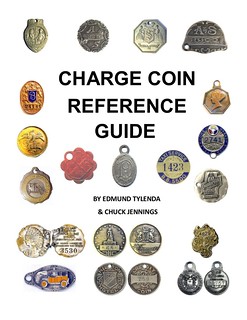 First Edition 2018 CHARGE
COIN REFERENCE GUIDE. 314 pages, coil bound, full of detail and images. iNCLUDES NEW TYL ATTRIBUTION NUMBERS Over 1500 different coins cataloged and imaged in life sized
color. Discount to American Credit Card Collectors Society ( ACCCS ), Members price will be $59.00 plus postage ACCCS Members should request an invoice. Shipping by US US Postal
Service Priority mail. Boxed at $14.50 or in media mail envelope for $7.00. Priority mail in soft envelope for 11.50.
First Edition 2018 CHARGE
COIN REFERENCE GUIDE. 314 pages, coil bound, full of detail and images. iNCLUDES NEW TYL ATTRIBUTION NUMBERS Over 1500 different coins cataloged and imaged in life sized
color. Discount to American Credit Card Collectors Society ( ACCCS ), Members price will be $59.00 plus postage ACCCS Members should request an invoice. Shipping by US US Postal
Service Priority mail. Boxed at $14.50 or in media mail envelope for $7.00. Priority mail in soft envelope for 11.50.
Not trying to make money on shipping- you pick what you pay for shipping. Catalog is too heavy for first class mailing. Ask for invoice. Arrangements are made as you request, and postage paid by Buyer. A total of 314 pages with descriptive detail, and full life-sized color images of over 1400 different charge coins and tokens. INCLUDES VALUATION GUIDES.
The Guide required 6 full years of location, attribution and detailed description by the co-authors. This Guide is not just a catalog of one collection, but is rather a compendium of all known and attributed Charge Coins, covering also Firestone Charge Coins, and Mavericks. Includes not only beautiful images of most coins, but also aids to identify coins and their Issuers. ACCCS website is: creditcollectibles.com .


To order on eBay, see:
Charge Coin Reference Guide Book on Charge & Credit
Coins; coins keys TYL ##S (https://www.ebay.com/itm/Charge-Coin-Reference-Guide-Book-on-Charge-Credit-Coins-coins-keys-TYL-S-/292651135171)

NEW BOOKS: AMERICAN JOURNAL OF NUMISMATICS 29 & 30
Two new volumes of the American Journal of Numismatics have been published by the American Numismatic Society. -Editor
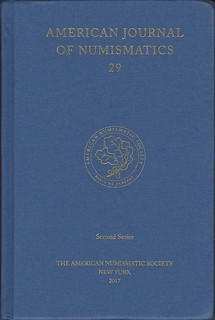 American Journal of Numismatics 29
American Journal of Numismatics 29
Hardback, illus., 275 pp., 38 plates
ISSN 1053-8356
ISBN 13: 978-0-89722-348-5
Price: $75.00
Ute Wartenberg, Editor
David Yoon, Editor
Oliver D. Hoover, Managing Editor
Contents:
- Nathaniel J. Andrade. The Silver Coinage of Syrian Manbog (Hierapolis-Bambyke)
- Lloyd W. H. Taylor. The Damaskos Mint of Alexander the Great
- D. Alex Walthall. Numismatic Material from Late Third-Century Contexts at Morgantina (Sicily)
- Jane Sancinito. The Antiochene Coinage of Trajan Decius (249–251 CE)
- Peter Bartlett, David Yoon, and Ruth Pliego. Weight, Fineness, and Debasement in Visigothic Tremisses from Theudis to Leovigild: New Evidence from the Hoards of Seville and Reccopolis
- Anwer Ahmedzhanov. Hedlinger’s Rouble
- Phillip B. Wagoner and Pankaj Tandon. The Bahmani “Currency Reform” of the Early Fifteenth Century in Light of the Akola Hoard
- Michael Zachary. The General Issue Ten-Cash Coins of the Republic of China: Noteworthy Examples in the ANS Collection
For more information, or to order, see:
American Journal of Numismatics 29 (http://numismatics.org/store/ajn29/)
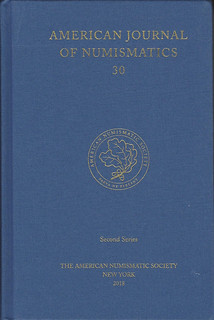 American Journal of Numismatics 30
American Journal of Numismatics 30
Hardback, illus., 275 pp., 38 plates
ISSN 1053-8356
ISBN 13: 978-0-89722-354-6
Price: $75.00
Ute Wartenberg, Editor
David Yoon, Editor
Oliver D. Hoover, Managing Editor
Contents:
- Lloyd W. H. Taylor. The Earliest Alexander III Tetradrachm Coinage of Babylon: Iconographic Development and Chronology
- Paul Vadan. The Posthumous Alexander Tetradrachms of Magnesia on the Maeander
- Oliver D. Hoover. The Personification of Apameia
- Clive Stannard, Jean-Albert Chevillon, and Alejandro G. Sinner. More Coins of the Pompeian Pseudomint from France
- Lucia Carbone. The Unpublished Iberian Lead Tokens in the Richard B. Witschonke Collection at the Amercian Numismatic Society.
- Georges Abou Diwan. Base-Metal Coinage Circulation in Byzantine Beirut, 491–641 CE
- Ruth Pliego. Kings’ Names on Visigothic Bronze Coins: A New Minimus from Ispali in the Name of Leovigild
- David Yoon, Sara T. Levi, Annunziata Ollà, and Gabriella Tigano. Medieval Coins from the Site of San Vincenzo on the Island of Stromboli, Italy
- Lyce Jankowski. History of the Chinese Collection at the American Numismatic Society
For more information, or to order, see:
American Journal of Numismatics 30 (http://numismatics.org/store/ajn30/)
NEW BOOKS: MINT TREASURER BENJAMIN RUSH
Dr. Benjamin Rush served as treasurer of the United States Mint from 1797–1813. Two new biographies shed light on his fascinating life and career. Here's an excerpt from a September 22, 2018 review in the Wall Street Journal. -Editor
 RUSH: REVOLUTION, MADNESS, AND THE VISIONARY
DOCTOR WHO BECAME A FOUNDING FATHER
RUSH: REVOLUTION, MADNESS, AND THE VISIONARY
DOCTOR WHO BECAME A FOUNDING FATHER
By Stephen Fried
Crown, 597 pages, $30
DR. BENJAMIN RUSH: THE FOUNDING FATHER WHO HEALED A WOUNDED NATION
By Harlow Giles Unger
Da Capo, 300 pages, $28
During the spring of 1813, former presidents John Adams and Thomas Jefferson were united in grief at the death of a mutual friend who had recently persuaded them to forget their bitter rivalries. Like the two celebrated statesmen, the eminent physician and social reformer Benjamin Rush had been a Founding Father, one of 56 men who signed the Declaration of Independence in 1776.
But Adams and Jefferson believed that Rush deserved to be remembered for much more than his conspicuous enthusiasm for the cause of American liberty. Jefferson wrote that “a better man, than Rush, could not have left us,” extolling his benevolence, learning, genius and honesty. Adams replied with equal praise: He knew of no one, “living or dead,” who had “done more real good in America.” Writing to Rush’s son, Richard, Adams maintained that as a “benefactor” to his country, the doctor deserved greater recognition than even the celebrated polymath Benjamin Franklin.
Today, while Franklin remains an undisputed giant of the Revolutionary generation, the other Benjamin eulogized by Adams and Jefferson is largely forgotten outside the ranks of historians and medical specialists. Now two authors—award-winning journalist Stephen Fried and seasoned historical biographer Harlow Giles Unger—have produced sympathetic and readable reassessments of Rush’s remarkable career, intended to secure what they consider to be his rightful place as a leading Founding Father.
To read the complete article, see:
‘Rush’ and ‘Dr. Benjamin Rush’ Review: American Hippocrates
(https://www.wsj.com/articles/rush-and-dr-benjamin-rush-review-american-hippocrates-1537493843)
INDE ET LIB FIXED PRICE LISTS ON NEWMAN PORTAL
The latest additions to the Newman Numismatic Portal are fixed price lists of dealer Kevin Vinton. Project Coordinator Len Augsburger provided the following report. -Editor
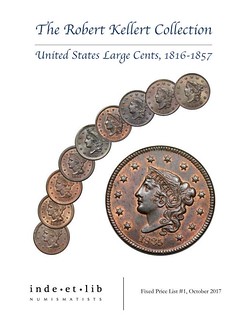
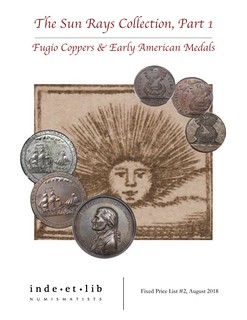
Kevin Vinton, dealer in colonial and early U.S. coins, has contributed a number of fixed price lists to Newman Portal. The Sun Rays Collection, Part 1 is one recent offering, featuring a notable collection of Fugio cents. Archived on Newman Portal, specialists in the series now have an additional resource for pedigree and price research.
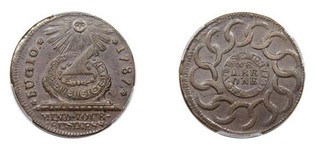 Included in this list was a plate coin from Eric P.
Newman’s “Varieties of the Fugio Cent,” published in Wayte Raymond’s Coin Collector’s Journal (January-February 1949). Newman’s work identified 25 obverse dies (dated 1787)
and 32 reverse dies and represented the first comprehensive die variety analysis of the series. This plate example, Newman 9-P, comes with a rich pedigree including Elder, Ryder,
Boyd, and Ford. F.C.C. Boyd loaned many Fugio cents to Newman for study and it is virtually certain this coin was among them.
Included in this list was a plate coin from Eric P.
Newman’s “Varieties of the Fugio Cent,” published in Wayte Raymond’s Coin Collector’s Journal (January-February 1949). Newman’s work identified 25 obverse dies (dated 1787)
and 32 reverse dies and represented the first comprehensive die variety analysis of the series. This plate example, Newman 9-P, comes with a rich pedigree including Elder, Ryder,
Boyd, and Ford. F.C.C. Boyd loaned many Fugio cents to Newman for study and it is virtually certain this coin was among them.
Image: Newman 9-P Fugio cent, from the Inde Et Lib Sun Rays Collection, Part 1 fixed price list, the plate coin from Newman’s ”Varieties of the Fugio Cent” (1949)
Link to Sun Rays Collection fixed price list:
https://nnp.wustl.edu/library/book/553105
Link to Inde Et Lib fixed price lists on Newman Portal:
https://nnp.wustl.edu/library/publisherdetail/522648
Link to Eric P. Newman’s “Varieties of the Fugio Cent”:
https://nnp.wustl.edu/library/book/535829
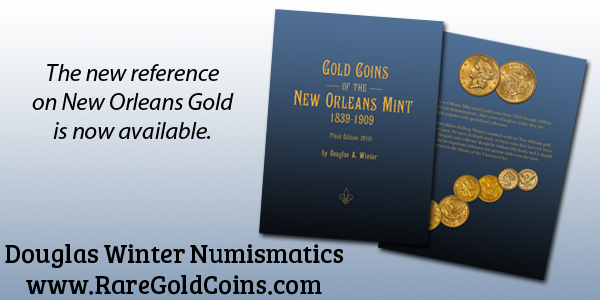
USING NATIONAL BANK CHARTER INFORMATION
Garrett Ziss submitted these thoughts on the National Bank database submitted to the NNP by Andrew Pollock. Thanks! -Editor
The Currency Club of Chester County (CCCC) has many members who collect national bank notes, so our club was quite interested in Andrew Pollock’s recent release to the Newman Numismatic Portal (NNP) of his compilation of the yearly listings of bank presidents, cashiers, bank assets and national bank note circulation during the note issuing period.
At the CCCC’s monthly meeting on September 20th, I gave a short tutorial on how to access this impressive database from the NNP and then several of us spent time checking it out.
One of our members, who has collected New Jersey Nationals for many decades, requested to look at Charter # 11658, The Beach Haven National Bank of Beach Haven. It had a bank officer change in 1935, right at the end of the note issuing period.
Another request was to view Charter # 100, which had 2 bank name changes and many bank officer changes during the small-size era of national bank notes from 1929-1935.
Overall, we spent the most time looking at entries from 1929-1935.
Those of us who viewed the database really appreciate Mr. Pollock’s dedication in compiling such a comprehensive, but easy-to-use database and think it will be a popular resource for national bank note collectors. For members who were not able to attend the CCCC meeting, information about the database and how to access it will be included in the club’s September Newsletter.
If you would like to learn more about the Currency Club of Chester County, please visit our website at http://currencyclubofchestercounty.com. Even if you don’t live close enough to attend the meetings, all members receive the club’s educational monthly e-newsletter.
To read the earlier E-Sylum articles, see:
NNP ADDS NATIONAL BANK CHARTER INFORMATION (http://www.coinbooks.org/v21/esylum_v21n34a07.html)
POLLOCK POWERFULLY PROVES PERSISTENCE PAYS (http://www.coinbooks.org/v21/esylum_v21n37a10.html)
MONEY TALKS: HISTORY OF THE ANS
The American Numismatic Society's next Money Talks forum will focus on the history of ANS itself. -Editor
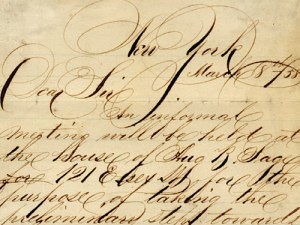 May the Little
Things Not Perish: The History of the ANS
May the Little
Things Not Perish: The History of the ANS
with David Hill, ANS Librarian and Archivist
Saturday, October 13, 2018
1:00
$30 members/$50 for non-members
Almost from the beginning, the motto of the ANS has been parva ne pereant (may the little things not perish), symbolically represented by an acorn growing into a mighty oak. Of course our great Society is also built upon the “little things” that fill its cabinets. Join ANS Librarian and Archivist David Hill for a look back at the ANS’s 160-year history, from its humble beginnings in a house on Manhattan’s Lower East Side, through some uncertain early years, past a few high-profile thefts, and up to the mighty scholarly institution that it is today. Beginning with the 1858 invitation letter sent out for the very first meeting of the American Numismatic Society, selections from the ANS Archives will also be presented.
Money Talks: Numismatic Conversations is supported by an ANS endowment fund generously given in honor of Dr. Vladimir Clain-Stefanelli and Mrs. Elvira Clain-Stefanelli.
To read the complete article, see:
May the Little Things Not Perish: The History of the ANS with David Hill, ANS Librarian and Archivist
(http://numismatics.org/money-talks-ans-history/)
CONTEMPORARY COUNTERFEIT U.S. COINS SOUGHT
Winston Zack submitted this request for assistance on circulating contemporary counterfeit U.S. coins. Can anyone help? -Editor
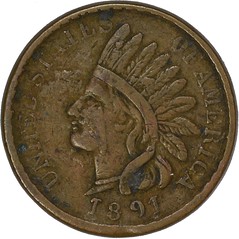
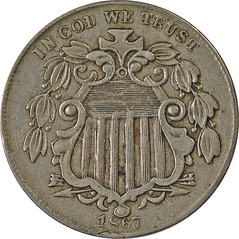
E-Sylum readers, I am in the editing stages of a book on circulating contemporary counterfeit U.S. coins, specifically copper (half cent, large cent, small cent, and two cent) and nickel (three cent and five cent) coinage; denominations in silver and gold will be published at a later date. As such, I am in search of images of a few remaining known (and any unknown/unreported/unpublished) struck circulating counterfeit varieties which I would like to include in my publication; I would very much like to not go to print missing images of any of these varieties. I am also looking for the highest quality images possible. My publication will credit the owner and photographer of each variety; the owner can remain anonymous if they specifically request such.
Below is a list of varieties I am specifically looking for. I am also happy to look at all other varieties you may own because I am collecting census data, and there could be nuances to those varieties, such as planchet alloy, die state, higher grade specimens, etc. which I have not yet recorded. I greatly appreciate any and all assistance you can provide me on advancing this area of numismatics.
1) Half-Cents: all struck contemporary counterfeits
2) Large Cents: all struck contemporary counterfeits except the 1817 and 1818 varieties as sold by Goldberg Auctions
3) Small Cents: all struck contemporary counterfeits except the 1891 Indian Cent
4) Two Cents: all struck contemporary counterfeits
5) Three Cent Nickels: all struck contemporary counterfeits
6) Shield Nickels: all struck contemporary counterfeits, especially those with a large 'X' counterstamped on each side.
7) Liberty Nickels: all struck contemporary counterfeits
8) Buffalo Nickels: any hand-made die-struck contemporary counterfeits; transfer die counterfeits not including those dated - 1916-S, 1927, 1930, 1935 (2 feathers), 1936 (2
feathers)
9) Jefferson Nickels: 1946, 1947 and 1953 Henning nickels; and 1939-D and 1950-D transfer dies
You may contact me directly to discuss this request in more detail at my email below:
winston.s.zack@gmail.com
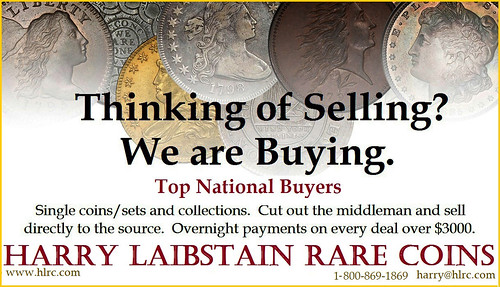
NOTES FROM E-SYLUM READERS: SEPTEMBER 23, 2018
Red Book Pricing
Bill Seldon writes:
I really didn't know where to start with this question so I thought I would start with you and your E-Sylum readers.
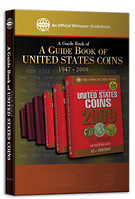 I am not really a book
collector, but I recently started collecting Yeoman Red and Blue books. I picked up a copy of Whitman's "A Guide Book of The Official Red Book of United States
Coins" authored by Frank Colletti. It has been somewhat helpful, but the pricing is 10 years out of date.
I am not really a book
collector, but I recently started collecting Yeoman Red and Blue books. I picked up a copy of Whitman's "A Guide Book of The Official Red Book of United States
Coins" authored by Frank Colletti. It has been somewhat helpful, but the pricing is 10 years out of date.
Have you or any of your readers heard about an updated addition of this book? If not can you suggest a website or a catalog that has updated auction prices of the earlier additions of the Red Book and Blue Book? Thanks for your help.
Well, newer editions of the Red Book have a small section in the back with updated pricing for old Red Books. I don't have the latest edition on hand to check if it's still there, but that's where you can find some more recent valuation data.
As for the Colletti book, I'm not aware of an update, but I'll check with our friends at Whitman Publishing. -Editor
To read the earlier E-Sylum article, see:
UPDATE ON THE GUIDE BOOK TO THE GUIDE BOOK (http://www.coinbooks.org/esylum_v13n16a06.html)
Michael Hodder Remembers Andrew Pollock
Mike Hodder writes:
I knew Andrew Pollock at Bowers & Merena in the 1980's. He was an indefatigable numismatic researcher, one of the masters of attribution, from colonials to territorials and everything in between. He didn't make mistakes. When I retired from cataloguing I kept only two numismatic books: my annotated copy of Breen (1988) and a bound copy of Andy's Numismatic Register. Someone still active should nominate him for the ANA Numismatic Hall of Fame.
Great idea. Thanks! -Editor
To read the earlier E-Sylum article, see:
POLLOCK POWERFULLY PROVES PERSISTENCE PAYS (http://www.coinbooks.org/v21/esylum_v21n37a10.html)
A Visit to the Katens
Dave Hirt of Frederick, MD writes:
Recently I found these photos of our visit with the Katens. I look so young. Where did the time go?
Numismatic book dealers Frank and Laurese Katen lived in Silver Spring, Maryland. One time me and John Burns drove down to Maryland from Pittsburgh where we met up with Dave and the Katens for dinner, then visited their home to see the Katen Numismatic Library. It was a memorable evening, and I learned quite a bit about U.S. numismatic literature. Thanks for the memories! -Editor
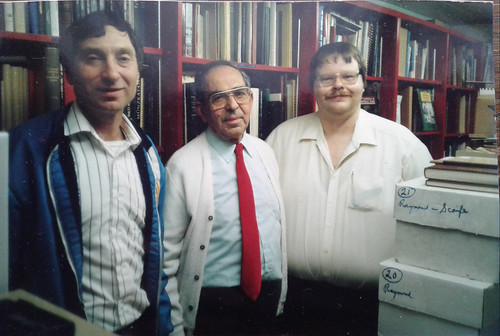
Dave Hirt, Frank Katen, John Burns
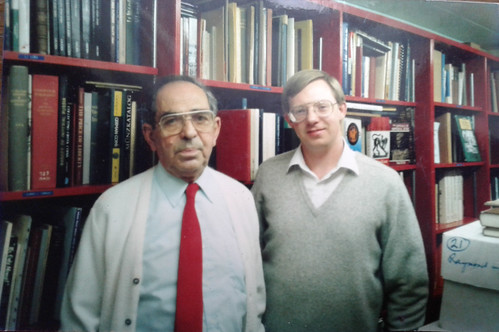
Frank Katen, Wayne Homren
The Case of the Crime-Solving Counterstamp
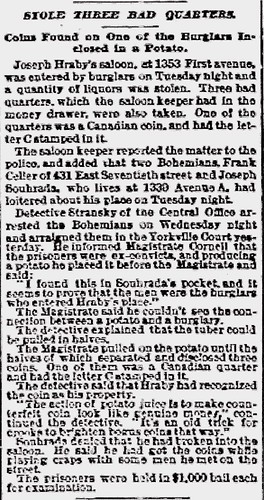 Bill Groom writes:
Bill Groom writes:
While doing some research on a counterstamped coin, I stumbled across the attached article. It was published in an 1898 edition of the New York Sun. The article tells of how a stamped, Canadian coin was instrumental in solving a crime. The coin proved to be a "security device" of sorts. I trust that many readers will find this story interesting and, perhaps, educational.
Thank you! Great story, although I'm still scratching my head over the potato. -Editor
Leatherbound French Catalog Survey Results
Jan Valentine writes:
Well, my informal survey came up with seven Leather bound Dr. French F.P.L.s known to exist. Four have a collector's name stamped on the front cover. They are as follows, Howard R.Newcomb, Col. E.H.R. Green, H.A. Sternberg, and Waldo Newcomer. Many thanks to Dan Hamelberg, Jim Neiswinter, and Bob Schuman for sharing.
Thanks for conducting the survey and sharing the results. It's good to know a number of these have survived. -Editor
To read the earlier E-Sylum article, see:
NOTES FROM E-SYLUM READERS: SEPTEMBER 9, 2018 : Leatherbound French Catalogs Sought
(http://www.coinbooks.org/v21/esylum_v21n36a08.html)
NOTES FROM E-SYLUM READERS: SEPTEMBER 16, 2018 : Leatherbound French Catalogs
(http://www.coinbooks.org/v21/esylum_v21n37a14.html)
Burzinski Communion Token Book Sought
Aaron Packard writes:
I’m on the hunt for a copy of the book "Communion Tokens of the World" by Lester M. Burzinski. Only 250 copies of the book were ever published, and Burzinksi himself self-published it. Any assistance or guidance in the matter would be most appreciated.
After going out of print, some books can prove quite hard to find. Can anyone help? -Editor
Woodworking Coins
Dick Johnson submitted this bit of coin humor. Thanks. -Editor
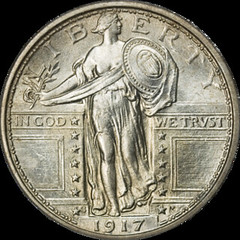 Phone rings.
Phone rings.
Dealer: Coin shop.
Elderly voice: It’s my grandson’s birthday. Do you have those woodworking coins?
Dealer: I don’t understand. What does he want?
Elderly voice: He says he wants some of those Liberty sanding coins.
Quick Thinking Dealer: Yes Ma’me. We sure do. Liberty is shown between two wooden chests of drawers. We got ‘em.
ICELANDIC TOKEN PHOTOS ONLINE
Yosef Sa'ar of Elat on the Red Sea provides this follow-up from our earlier article on the National Numismatic Collection of Iceland. Thanks. -Editor
Thanks to an article in The E-Sylum, I learned of the existence of a National Numismatic Collection in Iceland. Despite the fact that many, many tokens are known from other Scandinavian countries, I had never heard or seen a single token from Iceland! I visited for a few days last month and still couldn't find any tokens of any type. A rare bird.
After an email to the Iceland Central Bank and National Museum Numismatic Collection, I am happy to forward the following valuable information.
The museum does have a large collection of Icelandic tokens.
We are currently putting the collection online. Unfortunately the text is not in English but you should be able to use google translate to get you going.
Here are the merchant tokens http://www.sarpur.is/Syning.aspx?ID=633
And here are what is called the bread tokens http://www.sarpur.is/Syning.aspx?ID=634
If you follow this page you would be able to see the rest of the tokens when we put them online.
All the best
Sigurður Helgi Pálmason
Safnvörður | Numismatist
That's great to see. Museums everywhere are getting on the digital bus. Here are a couple tokens that caught my eye. Follow the above links to see the rest that have been imaged so far. -Editor
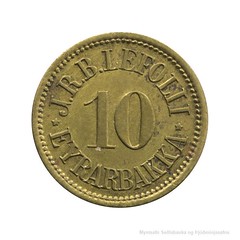
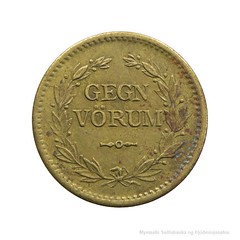
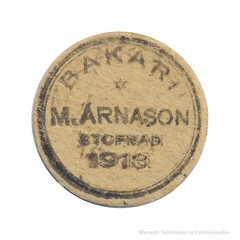
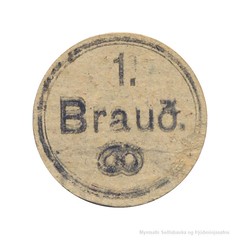
To read the earlier E-Sylum article, see:
THE NUMISMATIC MUSEUM OF ICELAND (http://www.coinbooks.org/v21/esylum_v21n36a19.html)
VOCABULARY TERMS: REISSUE, REPLICA, RESTRIKE, REVISION
Dick Johnson submitted these great entries from his Encyclopedia of Coin and Medal Terminology. Thanks! -Editor
Dick writes:
This is the second week for terms on copies and replicas; four terms all beginning with letters RE.
Reissue. A second or repeated issue, after a lapse of time, by an authorized issuer, with only a slight change, if any, in form or composition. A reissue occurs when a need or demand exists, as the reactivation of an award program where the original award medal is again produced. Or perhaps, a once popular medal is issued again after the death of the artist or copyrights have expired and the design is in public domain. COPY DIES are sometimes made to strike these reissued items if the original dies are no longer available. A reissue can be reinstated by the original sponsor or publisher, or by some new issuer who does have authority.
A reissue is not to be confused with RESTRIKE (issued without authority from original dies) nor is it to be confused with REVISION (a second or repeated issue requiring a
change in dies) by the same issuer. See COPIES AND REPLICAS.
CLASS 11.9
Replica A copy of a numismatic or medallic item, similar to but differing somewhat from the original piece. A replica is a copy and while the terms are not that precise in their difference from each other, a replica is somewhat more liberal in its exact replication; a major portion of the original design must be used for the replica. Most replicas are made after the death of its original artist and the art work is in public domain.
While a COPY is generally an exact duplication of the original (often with malicious intent), there exists a large body of replicas, most of which are highly legitimate and issued in good faith. A coin example would be the silver dollar bullion coin of 1986 which replicated Adolph Weinman’s Liberty Walking design of the 1916 half dollar; or the St-Gaudens' gold bullion American Eagle, a replica of his 1907 gold eagle coin.
Medal examples are more varied. All six medals made for the fledgling American states, authorized by Congress and struck in France before 1800, were replicated by the Philadelphia Mint and issued anew, even as late as 180 years after their first issue. The United States Diplomatic Medal, originally engraved by Augustin Dupre and struck in 1791, was among this group. It was reissued in 1876 (illustrated under the entry on REISSUE).
The Botetourt Medal, originally issued in England in 1772, and engraved by John Pingo, was given to students of William and Mary College in Virginia. It was so rare no description could be given by Betts in his work on American Colonial Medals (#528). In 1941 the College of William and Mary (who had one of the medals, of course) asked Medallic Art Company to replicate it. (It is discussed by Brown in his book, British Historical Medals, 1760-1960.)
In 1959, another medal by John Pingo was replicated and reissued. His Gibraltar Siege Medal of 1782 was struck by Medallic Art and issued by Prudential Insurance Company of America.
Other replica examples are illustrated under entries on CONTRAPOSITION (a replication of a Pasteur Medal) and AFTER (a replication of a 200th anniversary medal for a 300th anniversary). Thousands of replica examples exist. See COPIES AND REPLICAS.
In layman’s language the words “copy” and “replica” mean the same. Both terms cover all forms of copies in everyday language. Numismatists should use the exact terms listed in
this encyclopedia.
CLASS 11.9
References:
O2 {1894} Betts 528, p 234.
O40 {1980} Brown 154, p 35; 248 p 58.
Restrike. A numismatic item struck from original dies but at a later time than the original issue – coins struck in a year later than the date they bear, medals struck after an interval of time and regular issuing has ceased. Restrikes are often by dies in deteriorated state, usually (but not always) the restriking is unauthorized and mostly surreptitious.
A restrike denotes the use of at least one original die; if a replacement or COPY DIE is used (of the exact same designs but not made from the original hub or model) it is termed a NOVEDEL. The term restrike is not to be confused with REISSUE (which implies a proper authorization for use of the old dies) nor with REVISION (which implies the use of new copy dies or reworked old dies).
Restriking from old dies present several problems: rusting in the dies if improperly stored (dies will pit irregularly) and brittleness of the dies (may cause cracking, breaking or shattering of a die). Also old dies may exhibit a degree of SINKING. Pressmen must exercise great care during setup and striking to prevent breaking old dies. See COPIES AND REPLICAS.
The Paris Mint has restruck old dies for a series it calls “Original Dies” through their Le Club Francais de Medaille. Dies as early as mid 1600s have been struck side-by-side in soft tin rectangular plates. Each piece is serially numbered in a series limited to 300 such strikes. The soft tin is capable of obtaining an impression from the old and brittle dies, however, the tin is not a medium for creating permanent specimens. The tin is so soft a fingernail will dent it deeply; extreme care must be exercised in handling these pieces as anything heavier than a paper clip dropped on them – or dropping the item itself – will damage it extensively.
The French word for restrike is refrappe.
CLASS 11.9
Reference:
NE42 {1982} Doty, p 279-280.
Revision. A second or subsequent design replacing a prior design not considered satisfactory for further reproduction. Revisions of coins occur to change designs for better wearing qualities (as lowering of lettering on the reverse of the 1913 Buffalo nickel). Revisions of medals occur for a variety of reasons:
(1) Correcting errors of design or inscription.
(2) Change in sponsor’s name or title.
(3) Correcting mechanical errors.
(4) Change of seal or trademark.
(5) Addition of lettering.
(6) Removal of lettering.
(7) Modernizing design.
(8) Reinstating medal or sponsoring program.
Revisions almost always require reworking the original models or patterns and cutting new dies. See COPIES AND REPLICAS.
CLASS 11.9
Looking for the meaning of a numismatic word, or the description of a term? Try the Newman Numismatic Portal's Numismatic Dictionary at: https://nnp.wustl.edu/library/dictionary
Or if you would like a printed copy of the complete Encyclopedia, it is available. There are 1,854 terms, on 678 pages, in The Encyclopedia of Coin and Medal Technology. Even running two a week would require more than 19 years to publish them all. If you would like an advance draft of this vital reference work it may be obtained from the author for your check of $50 sent postpaid. Dick Johnson, 139 Thompson Drive, Torrington, CT 06790.
HENRY PHILLIPS, JR. (1838-1895)
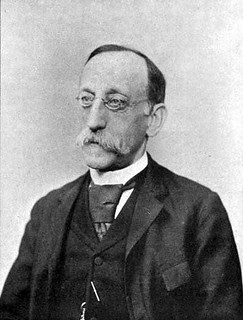 Henry Phillips, Jr. (1838-1895), born at
Philadelphia on September 6, 1838, son of Jonas Altamont Phillips (1806-1862), a lawyer, and Frances Cohen Phillips (1808-1890), both natives of South Carolina. Henry Phillips,
Jr., is so-called Junior since his father Jonas named his son after his brother Henry M. Phillips. So, he took on Junior in his appellation to distinguish himself from his
uncle.
Henry Phillips, Jr. (1838-1895), born at
Philadelphia on September 6, 1838, son of Jonas Altamont Phillips (1806-1862), a lawyer, and Frances Cohen Phillips (1808-1890), both natives of South Carolina. Henry Phillips,
Jr., is so-called Junior since his father Jonas named his son after his brother Henry M. Phillips. So, he took on Junior in his appellation to distinguish himself from his
uncle.
He came from a long line of very affluent Jewish intellectuals and cultivated men who worked as lawyers and who lived in South Carolina removing in the 1830's to Philadelphia, Pennsylvania.
He was educated at a Quaker School kept by Hannah and Mary Gibbons. He then studied classics at the Academy of Henry D. Gregory. In 1856, he graduated the University of Pennsylvania with a degree in Law following in his grandfather's footsteps, Zeligman Phillips.
He was a polyglot fluent in German, Italian, Spanish, Hungarian, and French.
In 1868, Corresponding Secretary, Numismatic and Antiquarian Society of Philadelphia. Also, a corresponding member of the Boston Numismatic Society. In numismatics he is largely known as an author of books on paper money. However, Phillips was a prolific writer on literature, history and culture as well.
On October 21, 1887, he served on the Committee of the American Philosophical Society that investigated the value of Volapuk as a potential replacement for Esperanto.
In 1888, his paternal aunt Emily Phillips donated $5,000 in memory of her deceased brother Henry M. Phillips to the American Philosophical Society to establish a prize fund in his honor.
On November 2, 1888, he donated to the Smithsonian a complete series of silver and copper coinages of the Congo State.
He died of complications of gouty arthritis and arteriosclerosis, resulting in uremia on June 6, 1895. He is buried at Mount Sinai Cemetery.
To read the complete article, see:
PHILLIPS, HENRY, JR.
(https://sites.google.com/a/numismaticmall.com/www/numismaticmall-com/phillips-henry-jr)
Here's a link to one of Phillips' publications on the Newman Numismatic Portal. Others include Historical Sketches of the Paper Currency of the American Colonies (1865) and Continental Paper Money (1866). -Editor
An historical sketch of the paper money issued by Pennsylvania : together with a complete list of all the dates, issues, amounts, denominations, and signers (https://nnp.wustl.edu/library/book/515922)
The entire inventory of the Lupia Numismatic Library is for sale. Individual items will be available before the remaining archives are broken up into parcels sold at philatelic auctions in the U. S. and Hong Kong. Check NumismaticMall.com frequently as dozens of new items with estimates will be posted daily until everything is sold.
All inquiries will be given prompt and courteous attention. Write to: john@numismaticmall.com .
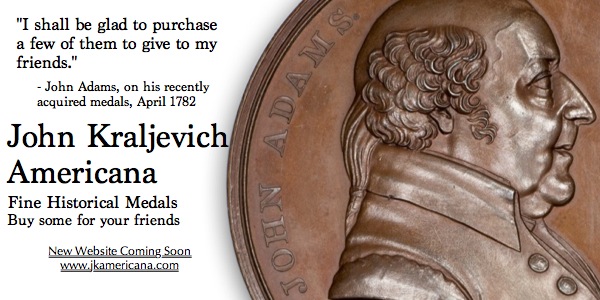
COLLECTORS UNIVERSE TERMINATES DAVID HALL
Thanks to Pete Smith, Kellen Hoard and others who passed along stories about the parting of David Hall from Collectors Universe. Here are short excerpts from stories in Coin Dealer Newsletter and Coin World. -Editor
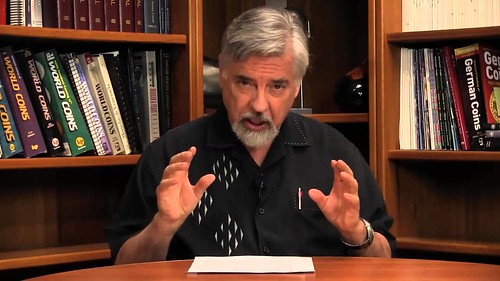
David Hall's Rare Coin Market Report - 04-15-13
Collectors Universe announced last night the departure of David Hall from his role as the company’s president and chief operating officer effective September 18, 2018. The news comes as a surprise to many in the numismatic community, and a brief press release from the company announcing Hall’s termination provides no details as to the reason for his immediate departure. Among the few other insights the report offers is that Joseph J. Orlando, the firm’s chief executive officer, will assume Hall’s duties.
To read the complete article, see:
PCGS Founder David Hall Departs Collectors Universe
(http://blog.greysheet.com/david-hall-departs-collectors-universe/)
David Hall, one of the co-founders of Professional Coin Grading Service and most recently president and chief operating officer of PCGS’s parent firm, Collectors Universe Inc., was abruptly terminated from his positions effective at the close of business Sept. 18.
Speculation regarding reasons for Hall’s departure ran rampant in posts on the U.S. Coin forum of the PCGS Message Boards.
Hall said he still plans to maintain a prominent presence in the world of numismatics and will take a more active role in David Hall Rare Coins, the Newport Beach, California, firm he founded more than 40 years ago.
“I love to buy coins and I love to sell coins,” Hall said. “I love to talk about coins and I love to write about coins. I can’t turn off my idea machine. There are plenty of things to do in the hobby. The coin market is strong right now in some areas, especially in generic gold. It’s almost like going out on the street and getting free gold.”
To read the complete article, see:
Collectors Universe terminates David Hall from companies he
co-founded (https://www.coinworld.com/news/us-coins/2018/09/david-hall-dumped-from-companies-he-co-founded.html)
See also this CoinWeek article:
PCGS Founder David Hall OUT at Collectors Universe
(https://coinweek.com/education/coin-grading/pcgs-founder-david-hall-out-at-collectors-universe/)
MINT NEWS BLOG INTERVIEWS DAVID FANNING
The Mint News Blog "Lunch with..." series interviewed numismatic literature dealer David Fanning. See the complete article online. -Editor
Q: What initially prompted your interest in the hobby?
A: A child at my elementary school brought a Whitman folder to share for “Show and Tell,” and something clicked. I don’t think I’d even noticed that coins had dates on them at that point. It appealed to the obsessive/compulsive aspect of the collector in me. But more importantly was that it made me track down a book about coins in our school library, which I proceeded to keep checked out for the better part of a year. I could have bought my own copy with what I ended up paying in overdue fees, I’m sure. It was the book that made me realize just how interesting coins could be, and how you could use them as a means to learn about the world—history, art, politics, geography, math, seemingly just about everything.
Q: What is your favorite coin and why (U.S. or international mint)?
A: A lot of my favorite numismatic items are medals: the Libertas Americana medal may be my favorite, though I love the Annapolis Tuesday Club medal. An NE shilling would be tough to beat if you want to stick to coins.
To read the complete article, see:
Lunch with. . . David Fanning (http://mintnewsblog.com/lunch-with-david-fanning/)
ARCHIVES FALL 2018 AUCTION #5
Here is the press release for the Fall 2018 Live & Online Auction #5 from Archives International. I've added images of selected notes that caught my eye. -Editor
U.S., CHINESE AND WORLDWIDE BANKNOTES, SCRIPOPHILY AND SECURITY PRINTING EPHEMERA WILL BE OFFERED IN 2 SESSIONS AT PUBLIC AUCTION ON THURSDAY, SEPTEMBER 27th, 2017
The auction will be held Online by Archives International Auctions, at their offices in Fort Lee, N.J.
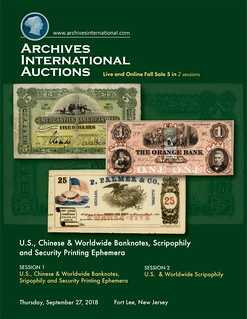 The
September auction will feature over 300 lots of of U.S., Chinese and worldwide banknote rarities as well as over 600 lots of rare and desirable U.S. and World Scripophily
including many examples from an old estate collection that have not been offered previously at auction and hundreds of additional banknotes, stocks, bonds, and autographs.
The
September auction will feature over 300 lots of of U.S., Chinese and worldwide banknote rarities as well as over 600 lots of rare and desirable U.S. and World Scripophily
including many examples from an old estate collection that have not been offered previously at auction and hundreds of additional banknotes, stocks, bonds, and autographs.
Included in the sale are consignments from numerous estates and longtime collections with many items having never been offered previously at auction. The sale is broken into two sessions, the first includes U.S., Chinese and Worldwide Banknotes, Chinese Scripophily, and Security Printing Ephemera. The second session consists of U.S. & Worldwide Scripophily with many rarities as well as numerous topics represented from Banking to Foreign to mining to railroads.
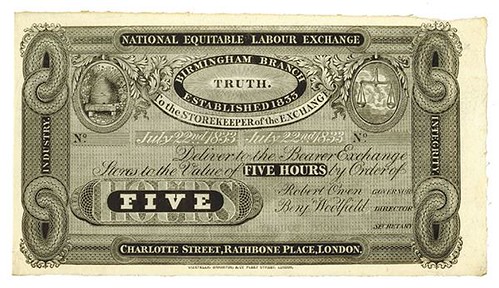
1833 Labour Exchange 5 Hour Certificate
The numerous highlights include over 60 lots of Chinese banknotes and Chinese Scripophily; a significant modern Replacement Note collection is offered as well as our usual large selection of worldwide scripophily.
The auction will feature hundreds of additional rare and desirable banknotes, coins, and scripophily in every price range, for the beginner to the advanced collector. Previews will be held at Archives International Auctions offices Tuesday, September 25th , and Wednesday, September 26th , from 10 AM to 5 PM and by appointment. For an appointment call 201-944-4800 or email info@archivesinternational.com .
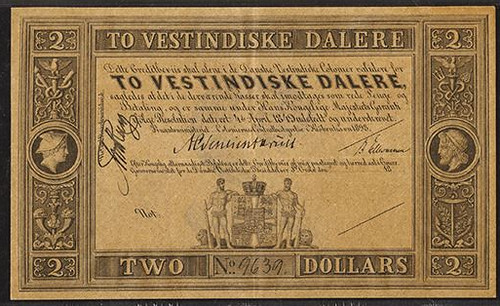
1898 Danish West Indies, 2 Dalere Banknote
The online catalog for the September 27th sale is on Archives International Auctions’ website and can be viewed via the Archives International live bidding platform. It can also be viewed as a virtual catalog or downloadable .pdf on their website. To pre-register for live internet bidding, log on to the Archives International Auctions website, at www.ArchivesInternational.com .
We are now working on our Winter 2018 and Spring 2019 auctions and are seeking quality consignments for future auctions or outright purchase including U.S. and worldwide banknotes, coins, stocks, bonds, stamps, postal history, historic ephemera, autographs. To sell or consign one piece or an entire collection, please call AIA at (201) 944-4800; or e-mail them at info@archivesinternational.com .
You may also write to Archives International Auctions, at 1580 Lemoine Ave., Suite #7, Fort Lee, NJ 07024 U.S.A. To learn more about Archives International Auctions and the auctions planned for September 27th, log on to www.ArchivesInternational.com .
Here are some additional selected lots from the sale. -Editor
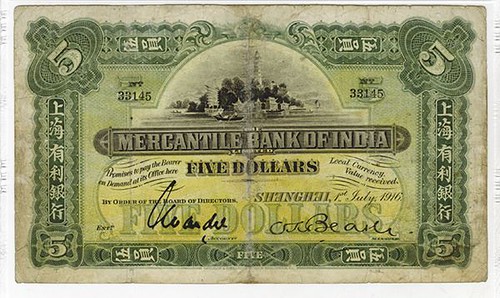
1916 Mercantile Bank of India Banknote
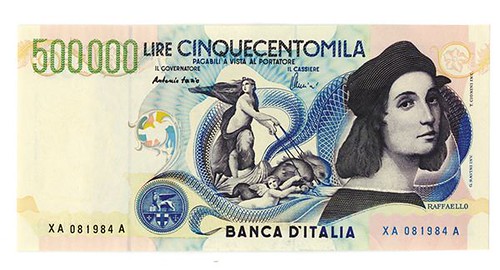
1997 Banca D'Italia Replacement Banknote
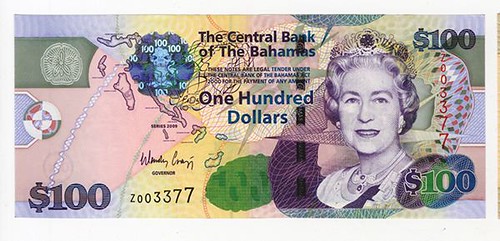
2009 Bahamas Replacement Banknote
SELECTIONS FROM FRANK ROBINSON AUCTION 106
Here are some lots that caught my eye in Frank Robinson's Auction 106, which closes October 23, 2018. -Editor
Lot 11: New Style Tetradrachm
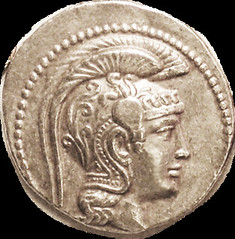
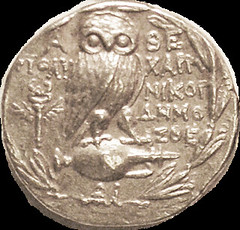
New Style Tet, Athena head r/Owl on amphora, winged caduceus at left, Thomp.376a; AEF, sl off-ctr, but a very nice example, good metal, strike & style. Ex Heritage 1/13 where it realized $881. Starting Bid $625
Lot 25: Hemidrachm of Cherronesos

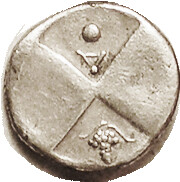
CHERRONESOS, Hemidrachm, 400-350 BC, Lion forepart/ rev divided in four, in one quarter A & pellet, grape bunch in other; as S1602;
Choice AEF, exceptionally well centered & struck with lion in fine style with strong detail. Excellent metal. What more can you want? (A VF of the type brought $212, CGB 10/08.) Starting Bid $85
Really. A great looking coin. -Editor
Lot 52: Knossos Labyrinth Bronze
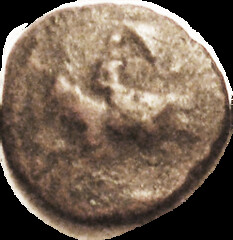
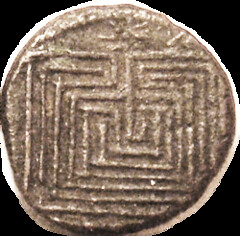
52 KNOSSOS, Æ19, c.220 BC, Bull & rider left/labyrinth, star above, S3228; AF/VF, brown patina, obv somewhat indistinct, labyrinth fully clear with only one corner off.
Rare & desirable type which always brings strong prices. (Better than a F, rough, weak in center, bringing $414, CNG 4/18.) Starting Bid $75
An interesting and unusual subject for a coin. -Editor
Lot 165: Tullius Roma Head
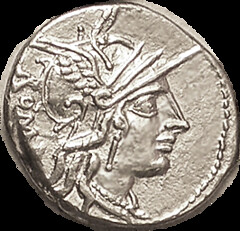
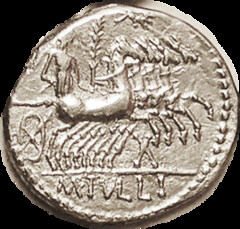
165 M. Tullius, 280/1, Sy.531, Roma head r/Victory in quadriga r, large X below; EF, virtually mint state, just a hair off-ctr on large oval flan, quite sharply struck; bright lustery silver. (An EF fetched $1220, Nomos 5/17. That's not fake news.) Starting Bid $175
Lot 400: Justinian I Gold Solidus
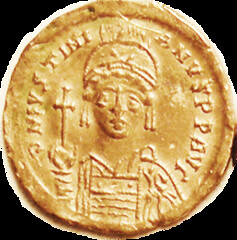
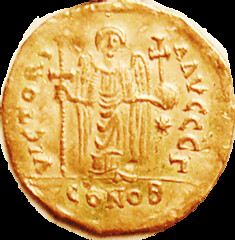
400 JUSTINIAN I, Gold Solidus, Facg bust/VICTORIA AVGGG-Gamma, Victory facg; S139; EF, well centered & struck, some sl obv scrs & somewhat wrinkly. Lemony gold. (A F+, wrinkly & scruffy, brought $381 on $425 bid in my 3/18 sale.) Min Bid $300
To read the complete online catalog, see:
http://www.fsrcoin.com/a.html
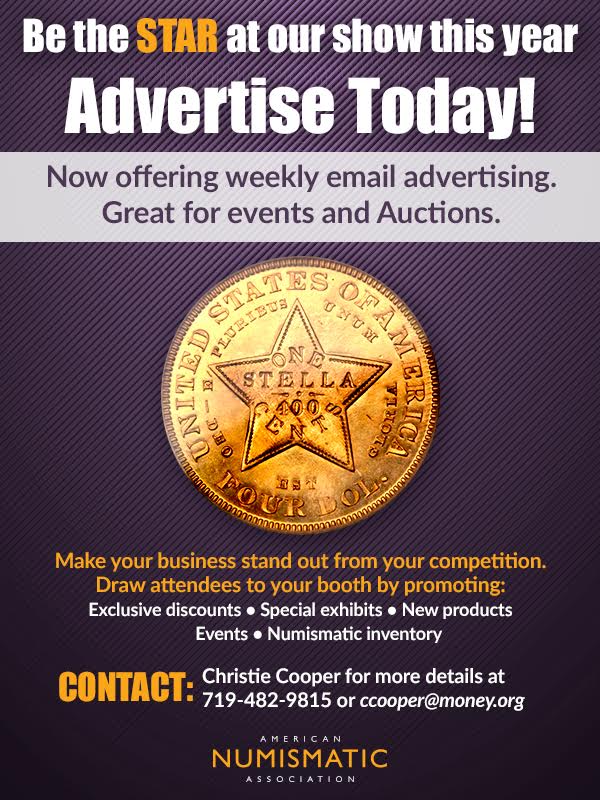
NUMISMATIC NUGGETS: SEPTEMBER 23, 2018
Here's a selection of interesting or unusual items I came across in the marketplace this week. Tell us what you think of some of these. -Editor
1748 Conococheague Pennsylvania Communion Token
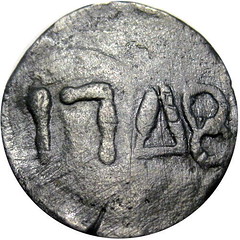
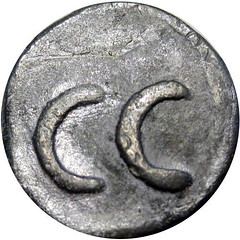
1748 Conococheague Pennsylvania Oldest Dated United States Communion Token, Burz 1364. C C. 1748.
A great eBay offering from Steve Hayden. -Editor
To read the complete lot description, see:
1748 Conococheague Pennsylvania Oldest Dated United
States Communion Token (https://www.ebay.com/itm/1748-Conococheague-Pennsylvania-Oldest-Dated-United-States-Communion-Token/223143714554)
1803 Harrison Silver Indian Peace Medal
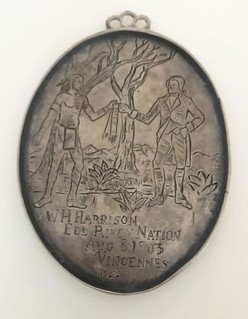
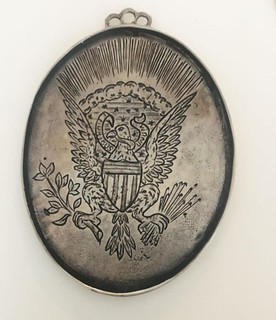
Description: The front shows an Indian Warrior handing a Wampum belt to an early American and reads, "Eel River Nation Aug 8, 1803 Vincennes. The reverse shows the eagle crest with the US shield in the center and wonderful detail.
What do people make of this one? Fake? -Editor
To read the complete lot description, see:
Lot 21: Harrison Presidential Silver Peace Medal ca. 1803
(https://www.invaluable.com/auction-lot/-1-c-90D4E1A927)
1857 Prince Edward Island Self Government Halfpenny
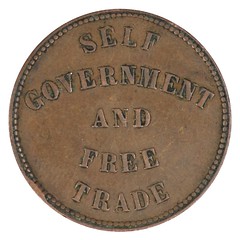
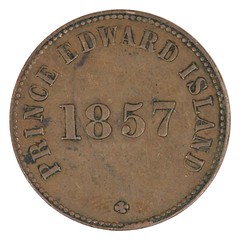
Canada. (Prince Edward Island) 1857 'Self Government and Free Trade' Halfpenny Token, Extremely Fine
A very plain political token from Smalls Auctions in Australia. Interesting relic and still relevant 161 years later in a world where we're still talking trade and monetary and political unions. -Editor
To read the complete lot description, see:
Lot 350: Canada. (Prince Edward Island) 1857 'Self Government and Free Trade' Halfpenny Token, Extremely
Fine (https://www.invaluable.com/auction-lot/-1-c-C114B84B6A)
Australia New South Wales Milk Token
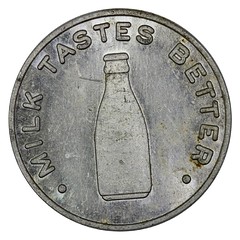
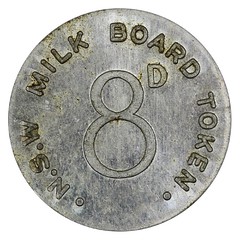
Another item from Smalls Auctions. This is a post-WWII item. From a web search I learned that the Milk Board was a regulatory agency formed in 1931. I'm not sure of the purpose of the tokens, but presumably these were purchased by consumers (or given to needy households) to pay for milk. Perhaps they were given to milk truck drivers so no cash would have to change hands along their route. -Editor
To read the complete lot description, see:
Lot 110: Australia Post WW11 - NSW Milk Board 8D Tokens (2 Tokens)
(https://www.invaluable.com/auction-lot/-1-c-D5849C5A08)
WAYNE'S NUMISMATIC DIARY: SEPTEMBER 23, 2018
Well, it's late Sunday evening and I still haven't found time to write the Diary I ran out of time for last week. But pictures are worth 1,000 words, so here are some pictures from my trip last week to the Pennsylvania Association of Numismatists (PAN) show in Monroeville, PA.
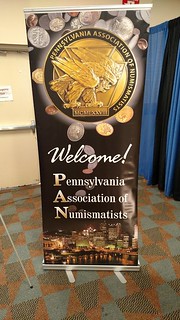
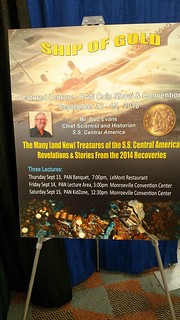
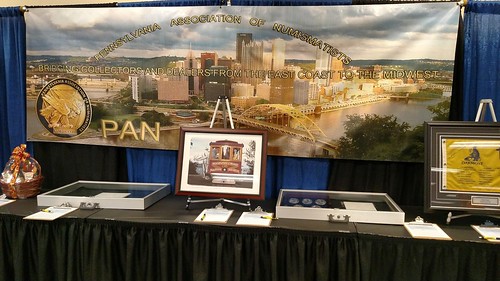
Silent Auction
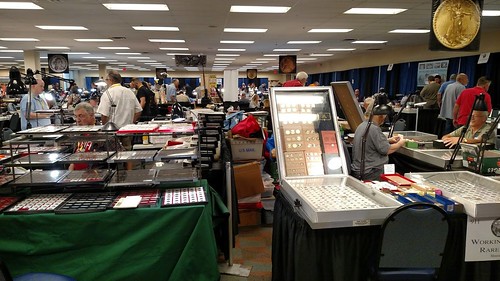
Busy Bourse Floor

More Bourse Floor

Paul Schultz using the Burns Memorial Library
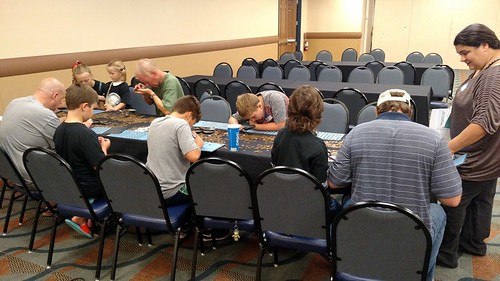
Kid Zone: Filling Penny Boards
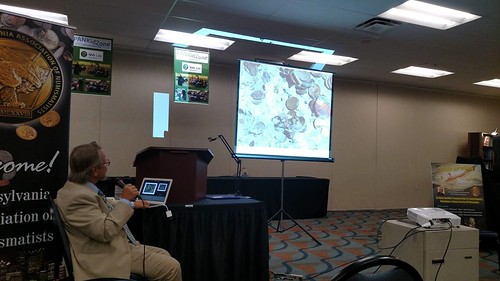
Bob Evans Speaking on the S.S. Central America
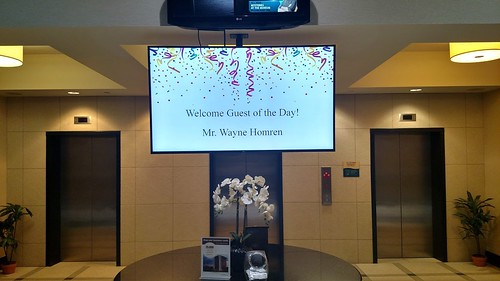
A Surprise From My Hotel
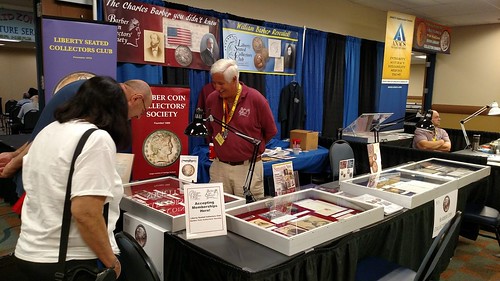
John Frost at the Barber Coin Collectors' Society table
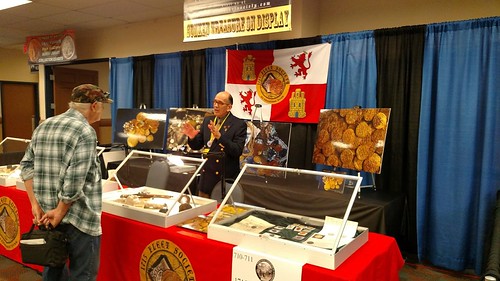
Ben Costello at the 1715 Fleet Society table
Heinz History Center Donation
In March the Newman Numismatic Portal announced the digitization of a group of original Pittsburgh bank ledgers from my library. At the show I met up with Bob Stakely of the
Senator John Heinz History Center and donated the books to their collection.
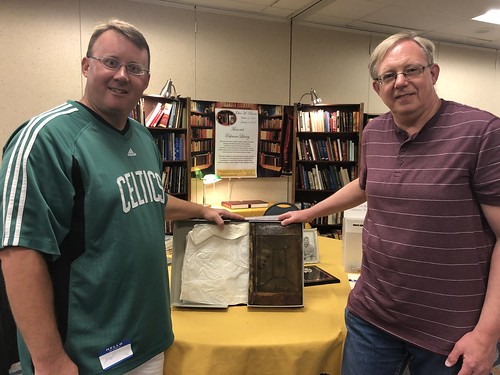
Bob Stakely and Wayne Homren
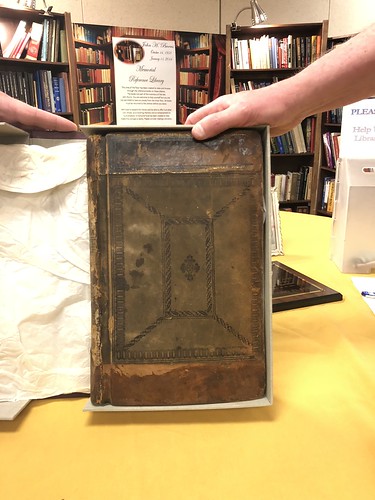
From the earlier article:
The latest additions to the Newman Portal are a set of minute books from two 19th century Pittsburgh banks, loaned by Wayne Homren for scanning. Although large format volumes, the Newman Portal has several options for scanning and is able to process material of varying sizes.
These books, luckily saved from destruction, capture the corporate proceedings of the institutions and detail the inner workings of banks of that era. They were produced in neat, easily readable script but are best viewed on a large screen.
Included are articles of incorporation, stockholder lists, and other administrative data. While there are many sources for published material ranging from booksellers to libraries to the Internet, access to manuscript material such as this has heretofore been problematic. With today's technology these barriers are disappearing, and we are pleased to have a role in making such resources widely available.
To read the earlier E-Sylum article, see: 19TH CENTURY BANK LEDGERS ADDED TO PORTAL (http://www.coinbooks.org/v21/esylum_v21n10a10.html)
COINS DISCOVERED FOLLOWING TYPHOON MANGKHUT
Dick Hanscom passed along this Daily Mail story from China about coins discovered in debris following typhoon Mangkhut. -Editor
 The report claimed that
residents were looking for ancient coins and they were from the Haifeng county in Shanwei city.
The report claimed that
residents were looking for ancient coins and they were from the Haifeng county in Shanwei city.
The crowd allegedly started to gather after one person claimed to have spotted under the debris of one house some silver coins from the Republic of China era, which were distributed about 100 years ago.
Some people were said to come with metal detectors and the scavenger hunt lasted from the afternoon to the night.
In response to the footage, a spokesperson from the Haifeng Culture, Broadcasting and News Publishing Bureau told Beijing Youth Daily the residents had managed to find 'dozens of silver coins' and had returned them to the owner.
To read the complete article, see:
Chinese residents flock to dig
'ancient silver coins' in the debris of collapsed houses after typhoon Mangkhut left
(https://www.dailymail.co.uk/news/article-6179943/Chinese-residents-flock-dig-ancient-coins-debris-typhoon-Mangkhut-destroyed-houses.html)
ROYAL MINT BOOSTS COLLECTIBLE COIN PRODUCTION
This September 21, 2018 article from the Telegraph discusses the increased production and collecting of special commemorative coins as workaday cash use decreases. -Editor
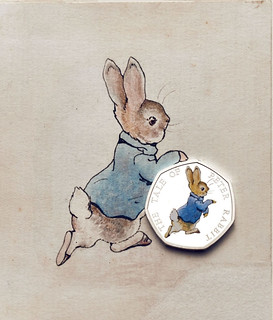 he Royal Mint has increased its
production of collectible coins in an attempt to appeal to a wider market as the use of cash declines across the country.
he Royal Mint has increased its
production of collectible coins in an attempt to appeal to a wider market as the use of cash declines across the country.
In August, economists at the Bank of England said that rising inflation was strengthening the case for the removal from circulation of copper coins, too often “lost to the ether” or “down back of the sofa”.
The number of 1p and 2pc coins produced by the Royal Mint last year fell by 76pc and 94pc respectively. The production of 10p pieces fell by 80pc – yet the official coin maker released a record number of commemorative 10p pieces in 2018.
This reduction is part of the Royal Mint's effort to expand its business services beyond cash. It opened the "Royal Mint Experience", a South Wales factory tour of the coins being made, at the start of the year, and plans to boost its profits by "adding sales and service to the historic coin collector market".
The latest series of 10p collectibles, the "Great British Coin Hunt", features images of British culture corresponding to each letter of the alphabet on one side of the coins. These include B for James Bond, C for cricket, F for fish and chips – and even Q for queueing.
A spokesman for the British Pobjoy Mint, a non-royal coin maker based in Surrey, said she has noticed the increase of young people taking part in coin collecting and other numismatic activities. Managing director Taya Pobjoy said the key is finding subjects that draw their interest.
Commemorative coin designs traditionally focused on royal occasions or significant events in political history. Recent releases have broadened the subject matter: they have marked 50 years of work by conservationists the WWF, and the 60th anniversary of Paddington Bear’s first adventure. This collectible had its own adventure, when a mistaken early release of a coin sold for more than £16,000 in June.
A spokesman for Westminster Collections, a distributor of collectible coins and stamps, said the rise in production of commemorative coins marking popular culture has led to people checking their change more frequently.
"There is definitely a noticeable increased interest, fuelled by numerous newspaper stories, the popularity of the Beatrix Potter 50p series and the introduction of the new 12-sided £1 coin and polymer banknote."
To read the complete article, see:
Collectible coin production rises as cash falls out of favour
(https://www.telegraph.co.uk/money/future-of-money/collectible-coin-production-rises-cash-falls-favour/)
EXHIBIT: MEDALLIC IMAGES OF WAR
An exhibit called Medallic Images of War: Death and Destruction 1850–1950 is on view at Medialia Gallery in New York through July 2019. -Editor
New Approach Contemporary Medallic Art Research Center
Through July 2019
Medallic Images of War: Death and Destruction 1850–1950
Curated by Scott Miller from the collections of David Simpson, Scott Miller, Normand Pépin, Dr. Jay Galst, Michael Parris, Dr. Ira Rezak, Frederic Withington
I reached out to Scott Miller, who kindly provided additional information. Thank you! -Editor
There are about 135 medals on loan from local collectors, with nearly all from the US and western and central Europe.
The purpose of this exhibit is to examine how medallic depictions of war, death, and destruction changed during the period from 1850 to 1950. The century covered by this exhibition saw tremendous advances in communication which affected the distribution, images and subject matter of medals. The greatest influence on medal design was the invention of photography, and the introduction of photojournalism.
Cultural influences on medals can also be seen, such as Victorian sentimentality on medals from the Boer War through World War I. In stark contrast to many medals produced by Allies where the value of the individual soldier was emphasized, some of the German World War I medals emphasized the soldier’s loss of individuality as well as the gruesome realities of war, with the Dance of Death a recurring theme.
By the Second World War, medals were largely replaced by other forms of communication, including magazines and newsreels. While some medals were produced depicting well known figures, remarkably few depict battles. In Germany, Guido Goetz followed in his father’s footsteps and issued a few satirical medals. However, as a part of the war machine, the medal, like the horse, was obsolete.
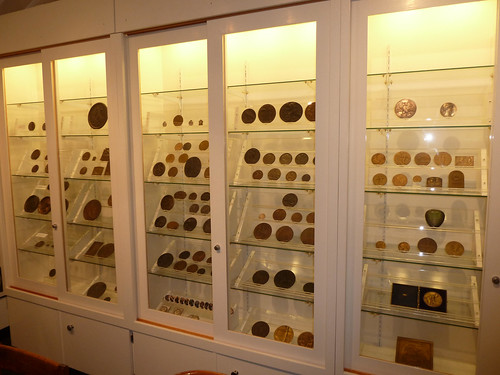
Medallic Images of War exhibit
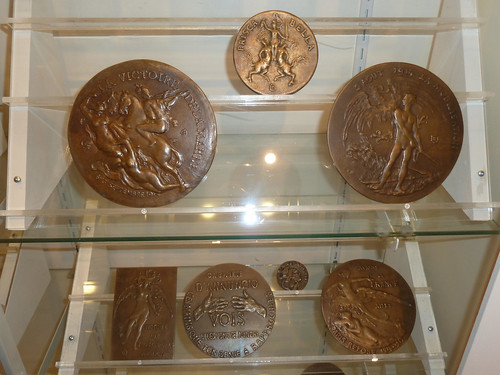
Medals by Pierre Roche

Gallery Owner Mashiko and Scott Miller
Looks like a great exhibit - well worth a trip into NYC. -Editor
For more information, see:
www medialiagallery.com
CARSON CITY COIN PRESS STRIKES NEWSPAPER MEDAL
The old Carson City Mint No. 1 coin press is back in the news. This article from CarsonNow.org notes that it will be used to strike a commemorative medal. -Editor
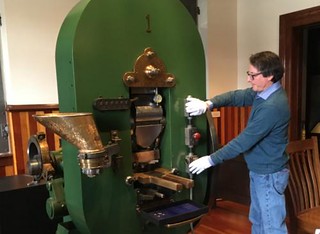 A limited-edition silver
medallion honoring the 125th birthday of The Nevada Sagebrush, the student newspaper of the University of Nevada, Reno, will be minted on the state’s most historic coin press in
Carson City.
A limited-edition silver
medallion honoring the 125th birthday of The Nevada Sagebrush, the student newspaper of the University of Nevada, Reno, will be minted on the state’s most historic coin press in
Carson City.
The “first-strike” ceremony is scheduled for 10 a.m. on Thursday, Sept. 20 at the Nevada State Museum in Carson City. Members of the Nevada Sagebrush Alumni Chapter, which privately funded the medallion, and current staff members of the Sagebrush will be in attendance along with museum staff.
The .999 pure silver medallions will be struck on the museum’s historic Coin Press No. 1, the same coin press that struck millions of dollars in gold and silver coins at the U.S. Branch Mint in Carson City in the late 1800s.
The medallion’s front features lettering from a 1940s era Sagebrush, a quill to represent journalism and a “Block N” to represent the university, and the famous “CC” mint mark. The back side of the coin is the seal of the state of Nevada.
“We wanted something special for the 125th anniversary and felt that a limited edition of 125 medallions would be a fitting tribute,” said Amy Beck, president of the Nevada Sagebrush Alumni Chapter. “Tying it in with state history and the old coin press makes it even more special.”
The medallions will be given as “thank you” gifts to the first 125 people who purchase tickets to the annual Sagebrush Alumni Chapter Dinner. The dinner is Oct. 19 – the 125th anniversary of the first edition of the newspaper – at Pinocchio’s Bar & Grill in Reno.
To read the complete article, see:
First-strike ceremony in Carson City set for
Nevada Sagebrush commemorative medallion (http://www.carsonnow.org/story/09/17/2018/first-strike-ceremony-carson-city-set-nevada-sagebrush-commemorative-medallion)
ROYAL CANADIAN MINT'S 3D SUPERMAN
I'm reluctant to call it a coin, but check out the new 3D Superman product from the Royal Canadian Mint. Thanks to Tom Fort for sending this. -Editor
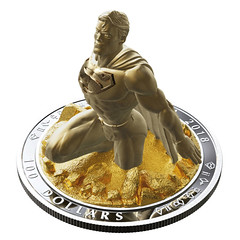
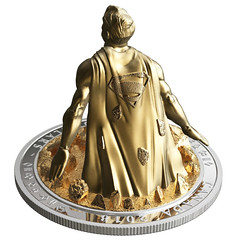
The coin is the latest in technological advances from the Royal Canadian Mint, whose product manager, Jamie Desrochers, is a big comic book fan. As soon as Desrochers saw the Mint’s new 3D coin technology in action on the Mint’s Majestic Canadian Animals series, he knew it had to be used for something comic book-y.
And being a comic book fan, he knew that you can’t just pull old Jim Lee art off a 1990s trading card and reuse it on something new. At least, not unless you’re Marvel comics. “You often find the same image of Superman across countless t-shirts and mugs. But what really resonates with people is original art, something they can’t find anywhere else. You have to respect the fans. Having original art is the best way to do that.”
So Desrochers enlisted fellow Canadian Fabok for the job.
“I had never seen anything like it,” said Fabok of the 3D coins. “But once Jamie showed me the elk statuette, my jaw hit the floor. I was so impressed by the creativity. It was the kind of thing where you say, ‘Yeah, I need that in my collection.’ And to do one with Superman? That’s even better.”
And so he did. Check out the process from concept sketch to finished product in the pictures below, and head over to the Royal Canadian Mint’s website if you want to plunk down a hundred bucks for one of these.
To read the complete article, see:
Check Out Jason Fabok’s $100 3D Superman Coin for the Royal Canadian
Mint (https://www.bleedingcool.com/2018/09/04/jason-fabok-100-3d-superman-coin-royal-canadian-mint/)
THE 3D-PRINTED HARRIET TUBMAN $20 STAMP
John Mutch passed along this September 18, 2018 article from Jason Kottke on a stamp someone made for overprinting an image of Harriet Tubman on $20 bills. -Editor
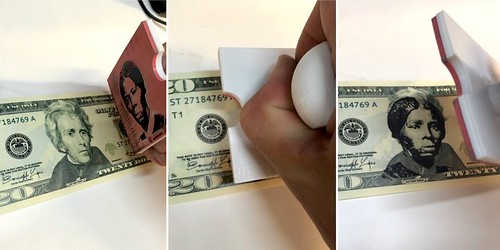
Frustrated that the US Treasury Department is walking back plans to replace Andrew Jackson on the front of the $20 bill with Harriet Tubman, Dano Wall created a 3D-printed stamp that can be used to transform Jacksons into Tubmans on the twenties in your pocketbook.
I was inspired by the news that Harriet Tubman would replace Andrew Jackson on the $20 bill, and subsequently saddened by the news that the Trump administration was walking back that plan. So I created a stamp to convert Jacksons into Tubmans myself. I have been stamping $20 bills and entering them into circulation for the last year, and gifting stamps to friends to do the same.
If you have access to a 3D printer (perhaps at your local library or you can also use a online 3D printing service), you can download the print files at Thingiverse and make your own stamp for use at home.
Wall also posted a link to some neat prior art: suffragettes in Britain modifying coins with a “VOTES FOR WOMEN” slogan in the early 20th century.
Here’s a video of the stamp in action. Wall told The Awesome Foundation a little bit about the genesis of the project:
John adds:
I suspect the growing popularity of 3-D printers will spawn a lot of things like this.
Have any of our readers encountered one of these in circulation yet?
The article continues with a discussion of the legality of overstamping banknotes with political or commercial slogans, with a quote from the appropriate statute. We've covered that territory before, but I appreciate this summary. -Editor
I’m not a lawyer, but as long as your intent isn’t to render these bills “unfit to be reissued”, you’re in the clear. Besides, if civil disobedience doesn’t stray into the gray areas of the law, is it really disobedience? (via @patrick_reames)
To read the complete article, see:
The Harriet Tubman $20 Stamp (https://kottke.org/18/09/the-harriet-tubman-20-stamp)
To watch the video: There I fixed it (https://vimeo.com/250692555)
For more information, see: HARRIET TUBMAN STAMP (https://tubmanstamp.com/)
I always like to point out that it was our old friend "Money Artist" J.S.G. Boggs who publicly proposed putting Tubman's portrait on U.S. paper money back in 1995 with a $100 design published in Worth magazine; it was the first in his Women's Series imagining a complete redesign of U.S. notes. -Editor

To read the earlier E-Sylum articles, see:
CONSIDERING THE CONTROVERSIAL J.S.G. BOGGS (http://www.coinbooks.org/esylum_v19n34a18.html)
HARRIET TUBMAN RECOMMENDED FOR THE U.S $20 NOTE (http://www.coinbooks.org/esylum_v18n20a15.html)
NEW EUROPEAN €200 AND €100 BANKNOTES
A World Mint News Blog article by Michael Alexander published September 20, 2018 discusses the two new European Central Bank issues. Here's an excerpt. -Editor
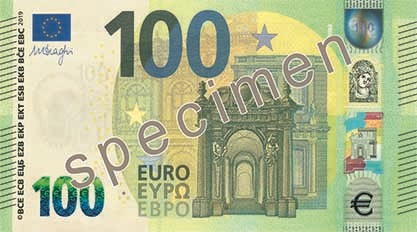
The European Central Bank (ECB) has unveiled (17th September) their two remaining denominations that will undergo an update in terms of design and security features. Begun in 2013 with the €5 banknote, the ECB introduced the new “Europa” series which updated the designs that were in use since the first euro-denominated banknotes entitled “Ages and Styles,” designed by Robert Kalina, that went into circulation on the 1st January 2002.
The two new 2019-dated notes retain their trademark colours of green for the €100 and yellow for the €200 denomination, but one significant change for these notes is that they will now be a different size. Both denominations are now the same height as the €50 banknote, with their length remaining unchanged — the longer the note, the higher the value. Since the €50, €100, and €200 banknotes are now the same height, this alteration means they can be more easily handled and processed by machines. They will also fit better in people’s wallets and last longer, as they will be subject to less wear and tear. The signature of both banknotes will include that of ECB President Mario Draghi, in office since 2011, and whose term is to expire in November 2019.
The new €100 and €200 banknotes make use of new and innovative security features. Just like the other denominations, these new notes are easy to check when using the “feel, look, and tilt” method first introduced with the earlier euro banknote series. At the top of the silvery stripe is a satellite hologram which shows small euro symbols that move around the note’s numeric value and become clearer under direct light. The silvery stripe also shows the portrait of Europa, the architectural motif and a large euro symbol. The new €100 and €200 banknotes also feature an enhanced emerald number which can be seen to the lower left on the front side of the notes. While the emerald number itself is present on all the other notes of the Europa series, this enhanced version also shows euro symbols inside the numerals.
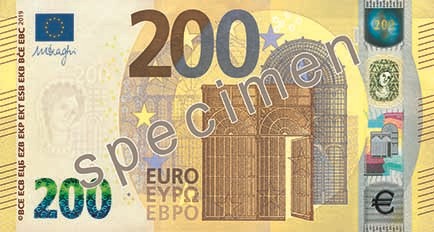
To read the complete article, see:
European Central Bank unveils new €200
and €100 banknotes as part of current Europa series
(http://world.mintnewsblog.com/2018/09/european-central-bank-unveils-new-e200-and-e100-banknotes-as-part-of-current-europa-series/)
Howard Berlin passed along this story. Thanks! -Editor
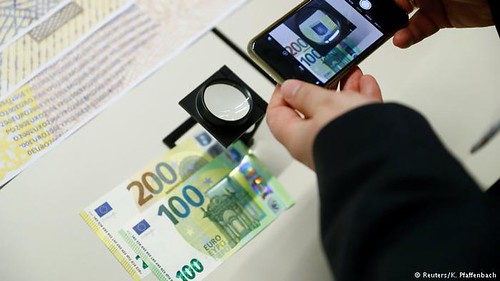
The new bills have also been updated to include the latest anti-counterfeiting features, including an improved "satellite" hologram of small euro symbols, while also being reduced in size to match the height of the €50 bill. That means notes will only be distinguishable by their length, with the longer ones bearing a higher value.
To read the complete article, see:
European Central Bank unveils new €100 and €200 banknotes
(https://www.dw.com/en/european-central-bank-unveils-new-100-and-200-banknotes/a-45525992)
And here's one found by Dick Hanscom. -Editor
To read the complete article, see:
New 100 and 200 euro notes unveiled (https://www.bbc.com/news/business-45553129)
NEW YORK STORE ACCEPTS MEXICAN CASH
Dick Hanscom forwarded this Daily Mail piece about a New York City shopkeeper accepting Mexican pesos from returning vacationers. Why not? -Editor
 Guillaume Guevara opened his
small store, Miscelanea NY, three years ago, selling Mexicans good in Manhattan's East Village.
Guillaume Guevara opened his
small store, Miscelanea NY, three years ago, selling Mexicans good in Manhattan's East Village.
Guevara knew of people who would travel south of the border, returning with great stories but also with the neighboring country's paper currency.
This normally meant Mexicans bills, and coins too, would just linger in their homes since they weren't accepted by businesses in the United States
The clever shop owner then just thought why not add the option of allowing his customers to pay with the Mexican peso at Miscelanea NY along with the customary method of the American dollar, credit and debit cards.
Guevara's innovative business idea took off last week and runs through the end of September.
And so far it's worked, according to a customer that spoke to Spectrum Noticias 1.
'I think it's a good idea being that a lot of people come from Mexico on vacation and they might have a certain amount of pesos and instead of exchanging them, they can come here to Miscelanea and purchase with pesos.'
Only Mexican bills are accepted under this unique, customer friendly concept. Any leftover change is handed back in the form of American currency
To read the complete article, see:
The Mexican goods store in New York that now accepts PESOS: Owner says
customers can pay with the currency to get rid of any spare they have left over from their vacation
(https://www.dailymail.co.uk/news/article-6182143/Mexican-goods-store-New-York-accepting-PESOS.html)
LOOSE CHANGE: SEPTEMBER 23, 2018
Here are some additional items I came across in the media this week that may be of interest. -Editor
Interview: Michael Gasvoda
CoinsWeekly published a nice interview with Michael Gasvoda, the new owner of Classical Numismatic Group (CNG) and recipient of the American Numismatic Society's Trustees’ Award. -Editor
To read the complete article, see:
Interview with the new owner of CNG, Michael Gasvoda
(https://www.coinsweekly.com/en/News/Interview-with-the-new-owner-of-CNG-Michael-Gasvoda/4?&id=5622)
Hyperinflation Through History
Phil Mernick of London and Dick Hanscom of Alaska forwarded this BBC News article on hyperinflation. Thanks. -Editor
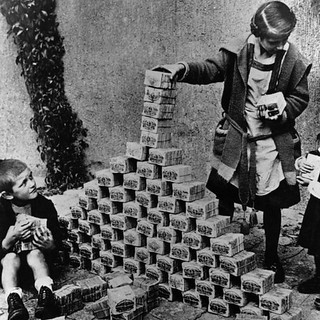 Venezuelans are living
through one of the worst hyperinflation episodes ever recorded since the end of World War Two.
Venezuelans are living
through one of the worst hyperinflation episodes ever recorded since the end of World War Two.
Prices have hit a new high in August, peaking at 65,000% a year, says Steve Hanke, a professor of applied economics at Johns Hopkins University, Baltimore, and one of the world's leading experts on hyperinflation.
Under President Nicolas Maduro, inflation stands at around 150% a month, says Prof Hanke - hyperinflation is defined as when inflation rates are greater than 50% per month and persist for more than 30 consecutive days.
While Venezuela is currently the only country in the world experiencing hyperinflation, there have been at least 58 episodes throughout history
The article highlights five well-known hyperinflation cases, all of which led to the production of high-denomination but nearly worthless banknotes: Hungary 1946, Zimbabwe 2008, Yugoslavia 1994, Germany 1923, and Greece 1944' -Editor
To read the complete article, see:
How do you solve catastrophic hyperinflation? (https://www.bbc.com/news/business-45523636)
And speaking of hyperinflation, Dick Hanscom forwarded this new photo gallery about the handbags and artwork Venezuelans are turning worthless cash into. -Editor
Hyperinflation has ravaged Venezuela’s economy, and its old bolivar notes are worth next to nothing. But for some enterprising artists, these useless notes are an economic opportunity.
To read the complete article, see:
The people making bags out of worthless money
(http://www.bbc.com/capital/gallery/20180918-the-people-making-bags-out-of-worthless-money)
THE CASE OF THE MURDEROUS NUMISMATIST
Greg Ruby publishes The Fourth Garrideb blog on the numismatics of Sherlock Holmes. The Case of the Murderous Numismatist is republished from the 2015 publication The MX Book of New Sherlock Holmes Stories, Part II: 1890 – 1895, by Jack Grochot. Here's a short excerpt. Check it out! -Editor
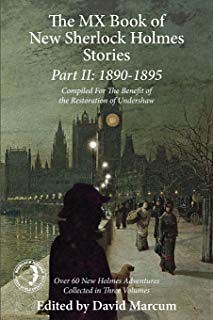 “Do you buy
rare coins at a fair price?” she asked.
“Do you buy
rare coins at a fair price?” she asked.
“What price I pay will beat any competitor’s, so help me God,” he swore.
“Well, then, I have six to sell. My dear father passed away and left me his collection. Before he went on to his reward, he told me which ones to part with if I fell onto hard times.”
“I won’t take advantage of you, miss,” he pledged. “Let’s see what you have.”
Gertie reached into her handbag and displayed the coins on the glass countertop.
“Hmm,” Smisky hummed, examining each one and replacing them into a row. “This one is worth five pounds to me, this one a little more, and the rest about ten pounds apiece – except this one,” he scowled, manipulating the counterfeit 1707 crown between his fingers, flipping it into the air with his thumb and forefinger, then catching it in the palm of his stubby right hand. “This one is worth nothing, not even face value,” he claimed.
“What in heaven’s name do you mean by that?” Gertie ejaculated, pretending to be stunned.
“It’s too heavy. It’s a replica, not the genuine article,” Smisky laughed.
“We’ll see about that,” Gertie snapped. “I’m taking it back, in fact all of them – I shan’t do business with a scoundrel.”
To read the complete article, see:
The Case of the Murderous Numismatist (2015)
(https://fourthgarrideb.com/2018/09/22/the-case-of-the-murderous-numismatist-2015/)
FEATURED WEB SITE: SILVER ART COLLECTORS
This week's Featured Web Site is the International Association of Silver Art Collectors (IASAC).The International Association of Silver Art Collectors (IASAC) was conceived over talks at the kitchen table of Steve and Agnes Rood in January 1985. One of these particpants was Ed Lantz who became the first President of the club. IASAC was founded to foster friendship and promote awareness and trade among the community of silver art collectors, dealers and producers. The club was originally called the International Association of Silver Bar Collectors (IASBC), however the name was changed at the first meeting of the organization in August 1985, to include round collectors as well.
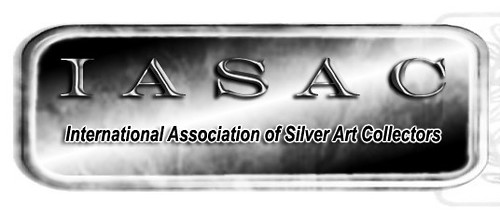
http://thesilverbugle.com/

